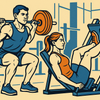Setting the Story Straight: 6 Easy Ways to Improve Your Posture

In a world where many of us spend long hours sitting at desks, hunching over screens, or driving, poor posture has become a common issue.
Good posture isn’t just about standing tall; it plays a significant role in your overall health, affecting everything from back and neck pain to your confidence and appearance.
Fortunately, with a few simple exercises and mindful habits, you can work towards better posture and a stronger back. Here are some practical tips to help you stand (and sit) a little straighter every day.
1. Be Mindful of Your Sitting Position
When sitting, it’s easy to slouch or lean forward, especially if you’re focused on a screen. Aim to sit with your back straight, shoulders relaxed, and feet flat on the floor.
Keep your hips and knees at a 90-degree angle, and if needed, use a small cushion or rolled-up towel behind your lower back to maintain its natural curve.
If possible, adjust your screen height so it’s at eye level, reducing the temptation to lean forward.
2. Strengthen Your Core and Back Muscles
A strong core and back are essential for maintaining good posture. Incorporate exercises that target these areas into your routine:
-
Planks: Planks engage your entire core, helping to build the strength needed to support your spine. Start with 20-30 seconds and gradually increase as you get stronger.
-
Superman: Lie face down on the floor with arms extended in front of you. Lift your arms, chest, and legs off the ground simultaneously, holding for a few seconds before lowering. This move strengthens your lower back.
-
Bird-Dog: On all fours, extend one arm forward and the opposite leg back, keeping your core tight. Hold for a few seconds, then switch sides. This exercise helps improve balance and stability while engaging your core and back.
-
Squats: Squats, both bodyweight and weighted, are excellent for building core strength while also targeting your lower body. Bodyweight squats can help improve flexibility and strength, while adding weights increases the challenge for your core, back, and legs.
-
Deadlifts: Deadlifts are a powerful exercise for strengthening your core and lower back. Whether using just your bodyweight (hip hinges) or heavier weights like dumbbells or a barbell, deadlifts engage your entire posterior chain and core, promoting better posture and overall strength.
3. Stretch Your Chest and Shoulders
Tight chest and shoulder muscles can pull your body forward, contributing to poor posture. Regularly stretching these muscles can help counteract this:
-
Chest Opener: Stand with your feet hip-width apart, clasp your hands behind your back, and lift your arms while opening your chest. Hold for 20-30 seconds.
-
Shoulder Rolls: Sit or stand with your back straight, and roll your shoulders up, back, and down in a circular motion. This simple movement can relieve tension and help with alignment.
4. Practice the "Chin Tuck" Exercise
Chin tucks help correct forward head posture, which is common among those who spend a lot of time looking at screens.
To perform a chin tuck, sit or stand with your back straight and gently pull your chin down and back towards your chest, keeping your gaze forward. Hold for a few seconds and repeat 8-10 times. This exercise helps strengthen the muscles at the front of your neck and aligns your head over your shoulders.
5. Stay Active and Avoid Prolonged Sitting
Movement is key to maintaining good posture. Try to stand up, stretch, or take a short walk every 30-60 minutes if you’re sitting for long periods.
Even brief movement breaks can help prevent the stiffness and muscle imbalances that contribute to poor posture.
Pro Tip: Sitting on the floor while watching TV can be an effective way to fight sitting in the same position for too long.
6. Check Your Sleeping Position
Your posture matters even when you’re asleep. To support your spine, sleep on your back or side rather than your stomach, which can cause your back to arch unnaturally.
Use a pillow that supports your neck’s natural curve and a mattress that’s comfortable yet firm enough to keep your spine aligned.
Stand and Deliver
Improving your posture is a gradual process that requires consistency and mindfulness. By incorporating these exercises and tips into your daily routine, you can work towards better alignment, reduce strain on your back, and promote overall well-being.
Remember, small adjustments can make a big difference over time – stand tall and take it one step at a time!








